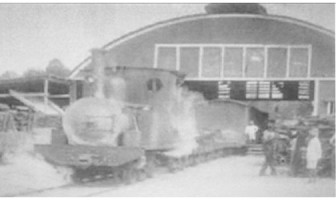Photos and text courtesy
of Mr Dmitri Allicock
The once popular 1897 Wismar- Rockstone railway symbolized upper Demerara and served as a cornerstone in its development before bauxite came to dominate. This railroad provided valuable and safe transportation for commuters and cargo to and from Essequibo and Demerara. It was Guyana’s first inland railroad.
On arrival in 1840, Hugh Sproston saw the dire need for transportation across Guyana’s waterways and hinterland. He introduced steam-powered vessels to ply Guyana’s rivers and built a dry dock where damaged vessels could be repaired and new ones constructed.

Sprostons had steam brigs or vessels plying the Georgetown route as far as Lucky Spot up the Demerara River from the 1850s.They were also other privately run vessels of that period. Access up the mighty Essequibo was a different matter. Navigation was impossible because of the many rapids and waterfalls. The idea was born to construct a railway from Wismar to Rockstone. The calm and navigable Demerara River would provide access from Georgetown to this railway at Wismar, with transportation continuing from Rockstone via launches to Tumatumari.

The lands and sawmill business of John Dagleish Paterson, of Christianburg, were bought by the government in 1892 to set up this railroad. Sprostons Company Ltd then constructed the Wismar to Rockstone Railway between the years 1895 and 1897. A loan of $200,000 was given to Sprostons by the government, to be repaid in twenty years without interest.
This light railway line as it was referred to, was 18¾ miles long and ran westward from the Wismar terminus to the Rockstone terminus (see pictures). It provided access through Guyana’s primaeval forest to the upper Essequibo and Potaro goldfields.

The steamer left Georgetown daily at 8am except on Sunday for Wismar. The train left daily from Wismar to Rockstone after the steamer arrived from Georgetown and not before 5.30pm. On Sunday the train did not run. At the Rockstone terminus, one or more launches with passengers and cargo provided a daily service at 6.30am to Tumatumari, with Sunday also being the day of rest. At Tumatumari, a launch provided daily transportation to Potaro Landing, taking passengers and cargo.

The turn of the 19th century saw this spanking new railroad linking the two rivers, moving people, equipment, timber, cargo, and most of all hope for a brighter future. Bauxite would later take over as the new king. The Demerara Bauxite Company would soon be established with the 1912 land purchased by George Bain Mackenzie. The year 1917 saw the first mining of bauxite at Akyma and the building of the bauxite plant and housing areas.

The sad ruins of the Wismar steamer stelling today, the tragic fire of April 12, 2011 of the Paterson house or Magistrate’s court, tells a tale of history lost. The last steamer to run the Linden-Georgetown route, the RH Carr (named after Ralph Hamilton Carr) decays at Skull Point on the Cuyuni River. That is hurtful for all those who can still remember. The faint essence of the rich historical past of Linden may still be recalled from the lonely waterwheel at Christianburg. Some of the railway lines of the Sprostons Wismar-Rockstone railway are still buried deep under Burnham Drive, although the memories of this precious treasure of Linden and Guyana are gone forever with the wind.
Understanding and respecting the past are the keys to the future.









